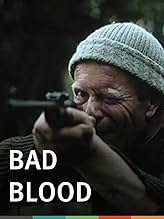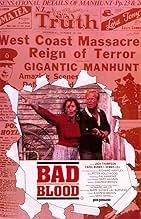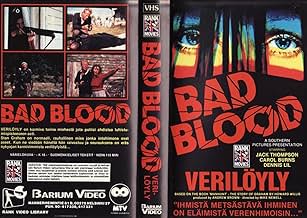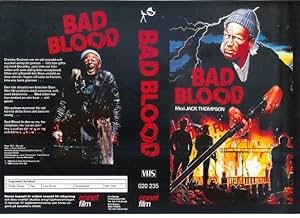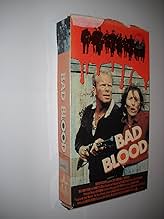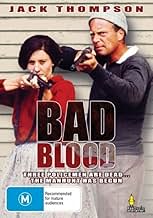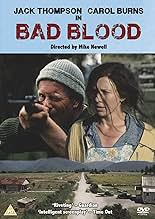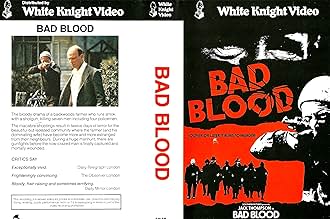अपनी भाषा में प्लॉट जोड़ेंDuring World War 2, a farmer in New Zealand murders seven people, and the police, along with local Maori trackers, hunt him in the bush country.During World War 2, a farmer in New Zealand murders seven people, and the police, along with local Maori trackers, hunt him in the bush country.During World War 2, a farmer in New Zealand murders seven people, and the police, along with local Maori trackers, hunt him in the bush country.
Alan Jervis Wilks
- Ralph Frederic
- (as Alan Jervis)
कहानी
क्या आपको पता है
- ट्रिवियाActors playing shot policemen, who had to lie on the floor in pools of blood for long periods of time, to relieve the boredom, would sing and whistle the Monty Python song "Always Look on the Bright Side of Life", which had been at the time recently popularized in the movie Life of Brian (1979).
- कनेक्शनFeatured in Century of Cinema: Cinema of Unease: A Personal Journey by Sam Neill (1995)
फीचर्ड रिव्यू
Don't let the badly chosen B-movie-ish title fool you, this film is better than that. Set in rural New Zealand during the early stages of WWII in the 1940s, this film portrays the true story of Stanley Graham, a poor farmer with a wife and two kids. Unable to connect with the more well-bred surrounding community, and treated as outcasts (part of that being their own fault), he and his wife become increasingly paranoid about the bank and mortgage companies foreclosing on their small plot of land because of their ever-increasing debts. Making matters worse, the local police chief confiscates Graham's best firearm for use in the war, further enraging him and convincing him that the whole town is out to get him and his family. When the police finally do come to confiscate his land, he cracks up - killing the officers, fleeing, and becoming a fugitive in what became the biggest manhunt in New Zealand history.
The best thing about this film is its topicality, which extends far beyond the specific time and place portrayed here. There are parallels here to the cases of David Koresh and Randy Weaver here in the U.S. - two other crazed rural isolationists obsessed with firearms and perpetuators of violence when confronted by government officials. In fact, director Newell does a fine job of setting up in the beginning just how central a role firearms play in the daily life of this isolated community - they seem to be everywhere in the first few scenes, and even children play with toy guns intensely. A film like this pokes holes in the rhetoric of the NRA which says defiantly, "Guns don't kill people, people kill people." Well, yes, Graham is slightly nuts from the beginning, but how likely would the massacre he creates have been had he not had such easy access to the rifles, which play such a central part in his psychology? Also, it is interesting to note that Graham seems to be the kind of competent professional with a firearm that the NRA so often endorses as its core consituency, yet we don't seem him using it for any legitimate hunting purposes at all - only to kill other human beings.
Australian veteran actor Jack Thompson, as always, turns in a fine performance as Graham - totally immersing himself in the role of a cloistered-up nutcase with the us-versus-them mentality which would lead to an inevitable standoff with the outside world. Not surprisingly, he is much more adept at using his rifles than his pursuers, killing and wounding just about everyone he fires at, and creating an intense hatred in the posse organized to catch him.
Newell has done an excellent job of creating the small period details of the setting, from showing the organized women's war production to the local dance and rationing for the war in this community. Additionally, Gary Hansen's cinematography and camera-work has an exquisite feel for the New Zealand Landscape.
The major flaw is that here is a film which has traces of further ambitions beyond itself, but unfortunately did not capitalize upon them. The build-up of Graham and his wife's paranoia following real and imagined humiliations from the community in the first half is riveting. Unfortunately, the second half loses steam, as the organization of the posse and manhunt seems rather inconsequential and pedestrian. Graham supposedly became something of a folk hero to the country, but this is only hinted at by one or two lines from peripheral characters. Newell would have been wiser to expand this theme further: the pathology of Graham is definitely universal, and there are likely traces of it in any isolated rural community. That is much more interesting than an obligatory chase. However, these flaws owe more to the script than Newell's direction, which is very accomplished. Throughout the entire film, Newell's direction retains the conviction that we are witnessing important historical events unfolding. It is too bad that the script does not delve much deeper than the superficial storyline of a nutcase who kills several people and get chased by the police. Still worthwhile, though.
The best thing about this film is its topicality, which extends far beyond the specific time and place portrayed here. There are parallels here to the cases of David Koresh and Randy Weaver here in the U.S. - two other crazed rural isolationists obsessed with firearms and perpetuators of violence when confronted by government officials. In fact, director Newell does a fine job of setting up in the beginning just how central a role firearms play in the daily life of this isolated community - they seem to be everywhere in the first few scenes, and even children play with toy guns intensely. A film like this pokes holes in the rhetoric of the NRA which says defiantly, "Guns don't kill people, people kill people." Well, yes, Graham is slightly nuts from the beginning, but how likely would the massacre he creates have been had he not had such easy access to the rifles, which play such a central part in his psychology? Also, it is interesting to note that Graham seems to be the kind of competent professional with a firearm that the NRA so often endorses as its core consituency, yet we don't seem him using it for any legitimate hunting purposes at all - only to kill other human beings.
Australian veteran actor Jack Thompson, as always, turns in a fine performance as Graham - totally immersing himself in the role of a cloistered-up nutcase with the us-versus-them mentality which would lead to an inevitable standoff with the outside world. Not surprisingly, he is much more adept at using his rifles than his pursuers, killing and wounding just about everyone he fires at, and creating an intense hatred in the posse organized to catch him.
Newell has done an excellent job of creating the small period details of the setting, from showing the organized women's war production to the local dance and rationing for the war in this community. Additionally, Gary Hansen's cinematography and camera-work has an exquisite feel for the New Zealand Landscape.
The major flaw is that here is a film which has traces of further ambitions beyond itself, but unfortunately did not capitalize upon them. The build-up of Graham and his wife's paranoia following real and imagined humiliations from the community in the first half is riveting. Unfortunately, the second half loses steam, as the organization of the posse and manhunt seems rather inconsequential and pedestrian. Graham supposedly became something of a folk hero to the country, but this is only hinted at by one or two lines from peripheral characters. Newell would have been wiser to expand this theme further: the pathology of Graham is definitely universal, and there are likely traces of it in any isolated rural community. That is much more interesting than an obligatory chase. However, these flaws owe more to the script than Newell's direction, which is very accomplished. Throughout the entire film, Newell's direction retains the conviction that we are witnessing important historical events unfolding. It is too bad that the script does not delve much deeper than the superficial storyline of a nutcase who kills several people and get chased by the police. Still worthwhile, though.
- Sturgeon54
- 16 जुल॰ 2005
- परमालिंक
टॉप पसंद
रेटिंग देने के लिए साइन-इन करें और वैयक्तिकृत सुझावों के लिए वॉचलिस्ट करें
विवरण
- रिलीज़ की तारीख़
- कंट्री ऑफ़ ओरिजिन
- भाषा
- इस रूप में भी जाना जाता है
- The Shooting
- फ़िल्माने की जगहें
- न्यूज़ीलैंड(filmed entirely on location in)
- उत्पादन कंपनियां
- IMDbPro पर और कंपनी क्रेडिट देखें
- चलने की अवधि1 घंटा 45 मिनट
- रंग
- पक्ष अनुपात
- 1.85 : 1
इस पेज में योगदान दें
किसी बदलाव का सुझाव दें या अनुपलब्ध कॉन्टेंट जोड़ें


